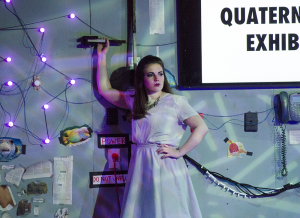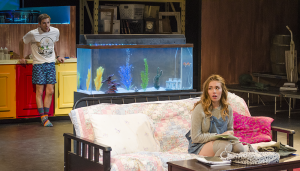
It’s the end of the world and two beautifully neurotic strangers — Jules, a gay scientist played by Taylor Mansmann (COL ’15) and Jo, a punky journalism student played by Emily Lett (COL ’17) — are stuck together in a biology lab as a comet hurtles toward Earth. In Peter Sinn Nachtrieb’s impishly intellectual play “Boom,” both Jo and Jules are looking for something better in their lives, something to claim for themselves, and are at each other’s throats trying to find it.
Jo wants sex: no-strings-attached, wild sex. She finds herself answering to Jules’ Internet ad promising just that. However, Jules is more concerned with the sleep cycles of fish and his outlandish theory that the behavior of his aquatic friends reveals that the apocalypse is nigh.
Jo doubts his prediction and seemingly just about everything else in life. She is looking to fill a void in her heart, but does not know what caused the void in the first place. Jules is possessed by the objectivity of science and Darwinism. His undershirt, quickly exposed by Jo in her attempts to seduce him, reads “Darwin is my Homeboy.’”
The show is a sharp cocktail that mixes together a handful of big and small concepts.
“A lot of the show is about control and how much autonomy we have. It can be taken in a religious perspective, in a scientific perspective, but it’s just the physical manifestation of the control we have over our lives,” producer Suzanne Coles (COL ’17) said.
There is no “right” answer or way to think about what is being presented in “Boom. “ Feeling a little lost? Nomadic’s technical director Adam Bacigalupo (COL ’16) wants you to know that this is the point.
“On the way into the play, it’s confusion, it’s weird, it’s off-putting, but it’s supposed to be like that. But on the way out, hopefully it makes sense,” he said.
“Boom” initially appears to be a play centered on these two impassioned characters and their psychological crises only to throw you for a loop when the character Barbara, played by Sarah Frasco (COL ’15), is introduced midway through the show.
Barbara emerges as a narrator from the future and presents the audience with her museum exhibit: the metaphorically significant tale of an odd couple and the fish they live with. Frasco’s role is a demanding one; she operates on a different plane than the other actors — literally. This twist throws the play into another stratosphere of weird just when you think you were maybe putting your finger on the meaning behind the chaos on display.
Are Jo and Jules autonomous or is Barbara in complete control of them? Who controls Barbara? What does this have to do with fate and the end of the world? Director Johan Clarke (COL ’15), who made a courageous decision shepherding “Boom” onto Georgetown’s campus, addresses this confusion.
“‘Boom’ demands us to think about our fates and identities without providing many answers. Being able to let go and realizing you won’t be able to control everything in your lives is at the play’s forefront,” Clarke said.

Taylor Mansmann (COL ’15) gives a flawless performance as scientist Jo along with Emily Lett (COL ’17) who plays the intriguing Jules in nomadic’s “Boom.”
Lett, Mansmann and Frasco all deliver flawless performances that leave the audience doubled over in laughter one minute and reflecting on the state of mankind the next. At its heart, “Boom” is a comedy, but it is also meant to evoke reflection.
“There are a lot of funny moments in the show but we also want the audience to look at the show and honestly feel for the characters. Even though this play is a cosmic migraine, if they can feel one thing they connect to in this cosmic migraine, that’s what I want for them because this play is not just funny. I want them to feel more than laughter,” Lett said.
There is nothing linear about “Boom”’s storyline. The script is hectic, disjointed and at times schizophrenic, but it is a dizzying masterpiece that one cannot stop watching. Patience is a requirement, yet the show is not frustrating in its lack of concrete answers, but rather seems like a peculiar whirlwind. “Boom” is a trippy, poetic delusion, but by the end of the show, an amusing surprise will answer a lot of the nagging questions racing around the audience’s brain.
The value of intimacy and the human connection is also central to the show’s message.
“At Georgetown, there’s always so much pressure that we put on ourselves and we expect so much from ourselves, and each other to do something big,” Mansmann, who gives a tireless and honest performance, said. “In the show, Jo and Jules have the opportunity to be important, to be the last two people alive on earth. Ultimately, it’s just two people and their one success in life is having a connection. That connection is what mattered in their life.”
Despite some of the darker and more violent scenes, “Boom” ultimately takes an optimistic perspective on the end of the world.
“I think this show has put a lot of acceptance into my head — the idea that the world does go on, and I’m just a small part of that world. It’s a big thing to deal with at 21,” Frasco said. “We think we’re supposed to live forever, and, you know, we will, but the idea that no matter what the world will keep on spinning is important. YOLO, if you will. Just enjoy it.”
“Boom” will be performed Oct. 30 to Nov. 1 at 8 p.m., Nov. 2 at 2 p.m. and Nov. 5 to 8 at 8 p.m. in the Walsh Black Box. Tickets are $10 for students and $12 for general admission and can be purchased at the Davis Performing Arts Center or online at performingarts.georgetown.edu/boxoffice.


















